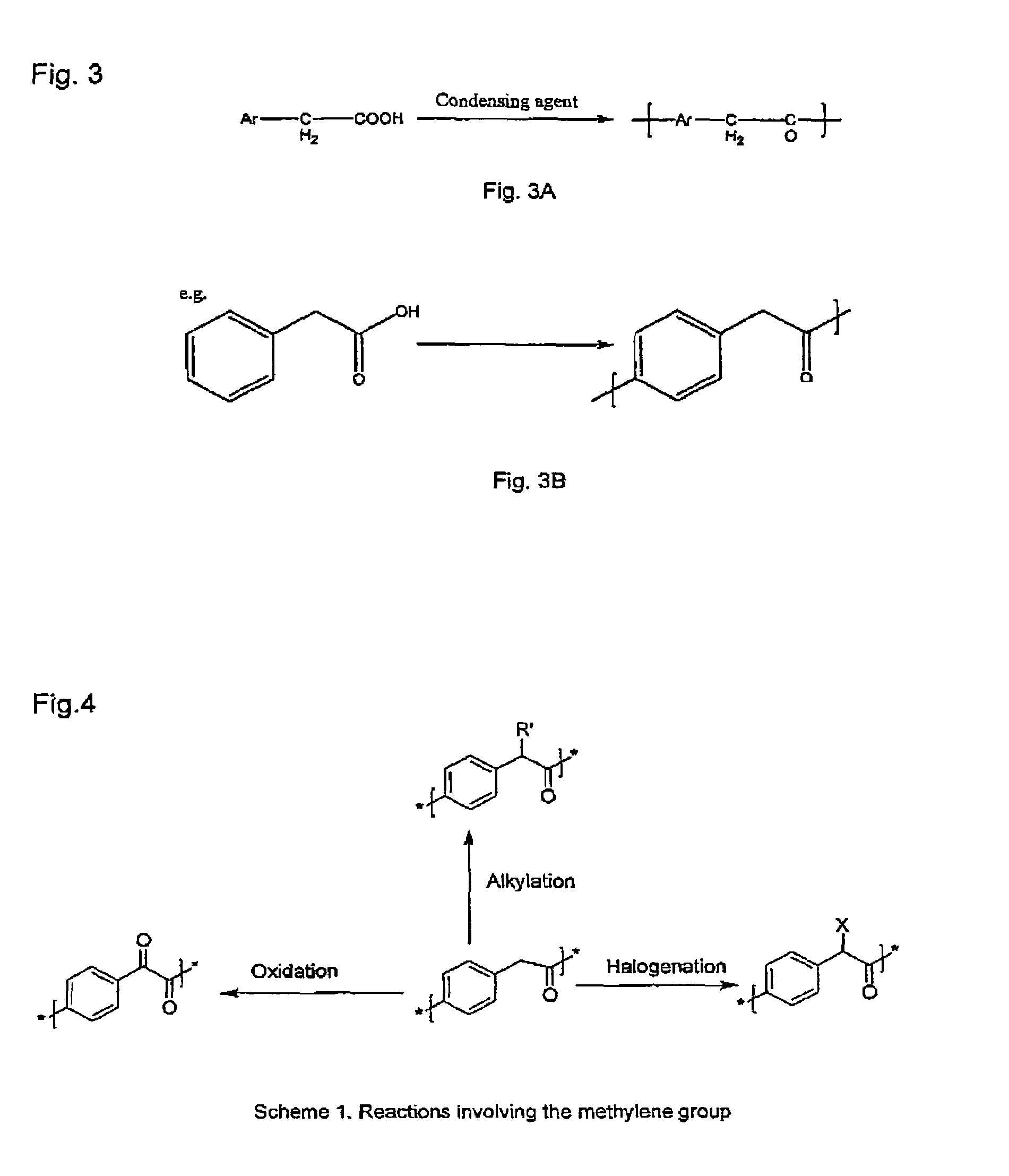Poly(aralkyl ketone)s and methods of preparing the same
a technology of alkyl ketone and polymer, which is applied in the field of poly(aralkyl ketone) s and methods of preparing the same, can solve the problems of high cost of monomers, large amount of inorganic waste in the process, and low molecular weight of polymers produced
- Summary
- Abstract
- Description
- Claims
- Application Information
AI Technical Summary
Benefits of technology
Problems solved by technology
Method used
Image
Examples
example 1
[0084]Phosphorus pentoxide (10.42 g, 0.0367 mol) was dissolved with stirring in 50 ml of methane sulfonic acid by heating the mixture at 80° C. in a 250 ml RB flask fitted with a drying tube. After complete dissolution the mixture was cooled down to room temperature. Phenyl acetic acid (5 g, 0.0367 mol) was added and the stirring continued at room temperature. On the 3rd day of stirring at room temperature an aliquot was withdrawn and added to water. A clear solution was obtained. On the 4th day an aliquot was withdrawn from the reaction mixture and added to water. A precipitate was observed. The reaction was terminated by adding the reaction mass into 1000 ml water. The precipitate was filtered off, washed repeatedly with water until the filtered water showed neutral pH and dried. The dried solid was then dissolved in tetrahydrofuran (THF) and precipitated in hexane. The purified polymer was then dried in a vacuum oven maintained at 50° C. for two days. Yield 2 g (46%). GPC (Polyst...
example 2
[0085]Phenyl acetic acid (10 g, 0.0734 mol) was added to a RB flask followed by phosphorus pentoxide (21 g, 0.0739 mol). The flask was fitted with a drying tube after adding 120 ml of methane sulfonic acid. The mixture was heated to 55° C. and held for 48 h. The flask was then cooled down to room temperature and the contents of the flask were poured into 2000 ml water. The solid obtained was filtered, washed repeatedly with hot water and then with water at ambient temperature until it showed neutral pH and then dried. After drying the polymer was dissolved in THF and precipitated in hexane. The precipitate was filtered and dried in a vacuum oven maintained at 50° C. for two days. Yield 5 g (57.63%). GPC (Polystyrene standards; THF eluent): Number average molecular weight, Mn=10829; Weight average molecular weight, Mw=43898. IR (KBr) cm−1: 3449(b), 3058(s), 3028(s), 1758(s), 1708(w), 1677(s), 1630(s), 1601(s), 1495(ss), 1367(s), 1222(s), 1180(s), 1148(s), 1113(s), 757(s), 700(ss) and...
example 3
[0086]Phenyl acetic acid (10 g, 0.0734 mol) was added to a RB flask followed by phosphorus pentoxide (21 g, 0.0739 mol). The flask was fitted with a drying tube after adding 90 ml of methane sulfonic acid. The mixture was heated to 70° C. and held for 24 h. The flask was then cooled down to room temperature and the contents of the flask were poured into 2000 ml water. The solid obtained was filtered, washed repeatedly with hot water followed by water at ambient temperature until it showed neutral pH and then dried. After drying the polymer was dissolved in THF and precipitated in hexane. The precipitate was filtered and dried in a vacuum oven for two days at 50° C. Yield 8 g (92.2%). GPC (Polystyrene standards; THF eluent): Number average molecular weight, Mn=24330; Weight average molecular weight, Mw=63477. IR (KBr) cm−1: 3453(b), 3058(s), 3027(s), 1761(s), 1711(w), 1677(s), 1630(w), 1601(s), 1495(ss), 1444(w), 1411(s), 1368(s), 1312(s), 1223(s), 1180(s), 1148(s), 1113(s), 965(s), ...
PUM
| Property | Measurement | Unit |
|---|---|---|
| temperatures | aaaaa | aaaaa |
| temperatures | aaaaa | aaaaa |
| temperatures | aaaaa | aaaaa |
Abstract
Description
Claims
Application Information
 Login to View More
Login to View More - R&D
- Intellectual Property
- Life Sciences
- Materials
- Tech Scout
- Unparalleled Data Quality
- Higher Quality Content
- 60% Fewer Hallucinations
Browse by: Latest US Patents, China's latest patents, Technical Efficacy Thesaurus, Application Domain, Technology Topic, Popular Technical Reports.
© 2025 PatSnap. All rights reserved.Legal|Privacy policy|Modern Slavery Act Transparency Statement|Sitemap|About US| Contact US: help@patsnap.com



